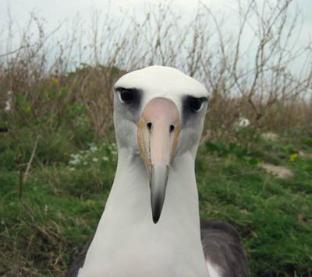Published in the Ocean Watch column, Honolulu Star-Advertiser © Susan Scott
January 3, 2011
Why would 16 people from Hawaii, California, Alaska, Washington state and Sweden, with occupations ranging from social worker to bicycle messenger to banker to geologist, volunteer to work over the holidays on a remote atoll while living in a World War II Navy barracks?
One word: albatrosses.

I wondered what my fellow census takers liked in particular about these birds and asked each to describe their favorite albatross behavior. The answers were as diverse as the volunteers themselves.
Joe, an Oahu physician, is amazed by these birds’ navigational abilities.
The search for flying-fish eggs and squid takes Midway’s albatrosses across thousands of miles of open ocean for months at a time, alone. Albatrosses nest together in huge colonies, but at sea they are solitary.
This atoll is only a few square miles of sand and reef midway (hence the name) between California and Japan, yet the birds find it. Each albatross also locates its precise nest spot within a few days of its mate.
“And these birds,” Joe added, “don’t even have GPS.”
A Seattle writer’s favorite albatross behavior is the look of gratitude the birds give her after she helps them.
Some albatrosses need help when their nest site gets overgrown with a weed called golden crownbeard or Verbesina. Midway residents brought this 3- to 8-foot-tall garden plant here decades ago, and it is now the Lord Voldemort of the atoll. Each daisylike flower drops about 350 wind-dispersed seeds, and albatrosses get tangled in the plant’s thick, woody stems.
The Seattle volunteer knows that seeing a “look of gratitude” on a bird is being anthropomorphic (attributing human characteristics to animals), but Midway will do that to a person. For most of us, there is no question that these birds have feelings.
Richard, a Big Island engineer, enjoys watching black-footed albatrosses stand tall on tiptoe and step, step, step like ballet dancers. The birds accompany these mating dances with a symphony of honks, whinnies, wails and bill clacks, filling the island with albie love songs.

UH astronomer Alan likes watching albatrosses take flight. To get airborne the birds run on their flat webbed feet with wings spread wide. Space is tight here, and sometimes running feet tread on brooding birds’ heads. The nesters seem unfazed.
Once in the air, an albatross is the picture of elegance, a quality that strikes Big Island resident Jenny, a former breeder of miniature donkeys. Her favorite activity is watching the birds ride the updrafts of breaking waves, or “air surf,” a behavior that looks like an exuberant game.
Tender egg talk touches Karen, a librarian from Manoa, and Rachael, a Big Island psychologist. It warms their hearts to see albatross parents stand up and lower their beaks to their egg. The soft “eh, eh, eh” bonds the future chick to its parents.
Our Swedish volunteer, Gunilla, sat down in the sand to rest and felt someone tap her shoulder. The gentle tapper turned out to be a nesting Laysan albatross who was, well, saying hello. Gunilla talked to the bird, and it let her lightly pet its head.
One of my favorite albie behaviors is young birds “playing house” by practice-gathering nest material. Once when I squatted to take a picture, I felt movement at my side and found an albatross pulling tissues from my gaping pants pocket.
We Midway counters are a diverse bunch who come here for a variety of reasons, but on one point we all agree: These remarkable seabirds have enriched our lives.
